BAA
VISUAL ECHOES BI-DIRECTIONAL GIMBAL HEAD ADAPTER (B-DGHA)
JAMES SHADLE/MASTER PHOTOGRAPHER/MASTER NATURALIST
JAMES SHADLE SPOONBILL BOAT TRIP OPENINGS
Important Request: if responding to this e-mail, please take the time to delete all images and all irrelevant text.
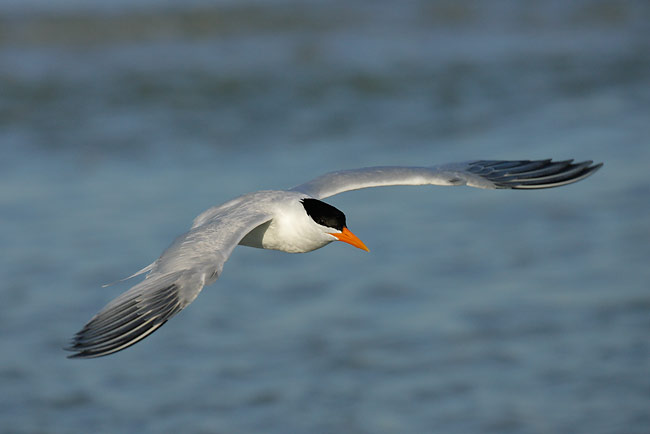
Canon 500mm
f/4 L IS Lens with the EOS-1D Mark IIN. ISO 400.
Evaluative
Metering +2/3 stop off the low sky: 1/2500 sec. at f/7.1 set manually.
BLOWING IN THE WIND
Many folks do
not understand the importance of wind direction on bird photography.
Here is an
excerpt from ABP II (http://www.birdsasart.com/ABPII.htm)
that explains the basics:
Here are the basics:
1. Wind and sun together (i.e. from the same direction): Ideal for flight,
good for birds on the ground or perched.
2. Wind and sun directions roughly 90 degrees from each other: Good to very
good for flight photography, excellent for stationary subjects. These are
perfect conditions for making images of birds parallel to the film plane. As a
general rule, I will photograph as much as ten to fifteen degrees off of the
light-angle to ensure that the subject is parallel to the film plane, but will
wait until the bird turns its head back into the light before making an image.
3. Wind against sun: Generally poor for all types of bird photography unless
you can find subjects in sheltered or shaded areas. (Note: When the conditions
seem to be poor at best, try to allow yourself to think outside of the box.)
Here are three
(brand new) additional possibilities that might work for you when facing
extreme wind against sun situations (a strong NW wind on a clear morning or
strong easterlies on a sunny afternoon):
1-Create backlit
images of birds in flight. This works especially well when the subjects are
landing as the light will often stream through the feathers. Be sure to check
for flashing highlights to avoid burning any white feathers and to check your
histogram to ensure that you are not underexposing darker subjects. This
approach works best with white birds like Snowy and Great Egrets and Snow and
Ross’s Geese.
2- With the sun
behind you, strive to create images of birds banking in flight as they turn to
land into the wind. Vertical compositions are often possible.
3-Stay home.
Do note that on overcast
days that north or west winds in the mornings or east winds late in the day do
not present a problem as overcast light is omni-directional. Understanding
the importance and the effect of wind direction on bird photography can help
you to create stronger images on a consistent basis.
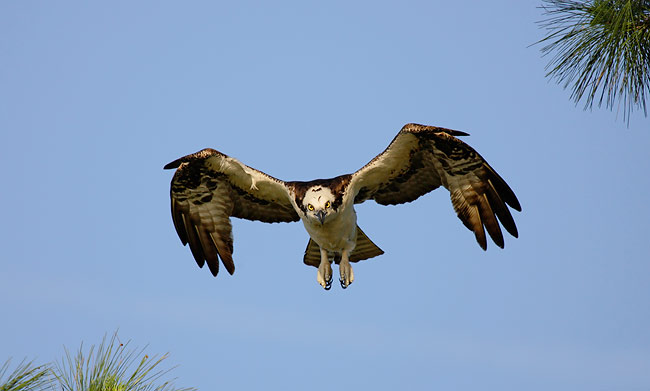
Osprey landing, Indian Lake Estates, FL
Canon
100-400mm IS L Zoom Lens handheld at 320 mm with the EOS-1D Mark IIN. ISO
400.
Evaluative
Metering + 1 stop off of low blue sky: 1/1000 sec. at f/6.3 set manually.
BAA
We are proud to
announce that the latest BAA Site Guide is now available:
A Guide to
A BIRDS AS ART Site Guide by Matthew Studebaker
I met Matthew
Studebaker last October when he graciously agreed to show me around the North
Chagrin Reservation on a speaking trip to
The guide gives explicit and clear directions (with great maps), best times to
visit, and expected subjects for eight major locations:
Crane Creek State Park (migrant songbirds, former IPT-site), Castalia, OH
(wintering ducks), East 72nd St., Cleveland (gulls—including rare species,
Red-Breasted Mergansers, and ducks), the aforementioned North Chagrin
Reservation (ducks—especially tame woodies, Canada Geese, American Robin,
migrant songbirds), Conneaut, OH (shorebirds, gulls, and terns), the Bath
Nature Preserve (migrant and nesting songbirds, Great Blue Heron rookery),
Cuyahoga Valley National Park (nesting songbirds especially warblers &
vireos, woodpeckers, and Chipping Sparrow), the Tri-valley Wildlife Area
(nesting songbirds especially sparrows—Henslow’s, Grasshopper, and Field,
Eastern Towhees & Meadowlarks, and Sedge Wren) and Shawnee State Forest
(migrant & nesting songbirds including Hooded, Cerulean, and Prairie
Warblers).
In addition,
there are lots of technique tips including an excellent section on judiciously
using tapes to attract songbirds. Matthew is a set-up master and the Site
Guide includes a how-to section with photographic examples and tips for
getting the birds to perch on the set up! Lastly there is a section noting
the locations of publicly accessible feeding stations in the state.
Matthew Studebaker’s BAA
Ohio Site Guide is sent via e-mail as a 5mb PDF file. To order yours, send a
check (made
out to "Arthur Morris"—be sure to include your e-mail address) or
a Paypal (easiest) for $50.
Alternatively, you can call us at 863-692-0906 with credit card in hand.
Matthew leads photo tours to various
You can contact Matthew by phone at 1- 440-423-0875 or via e-mail: matthewstudebaker@yahoo.com
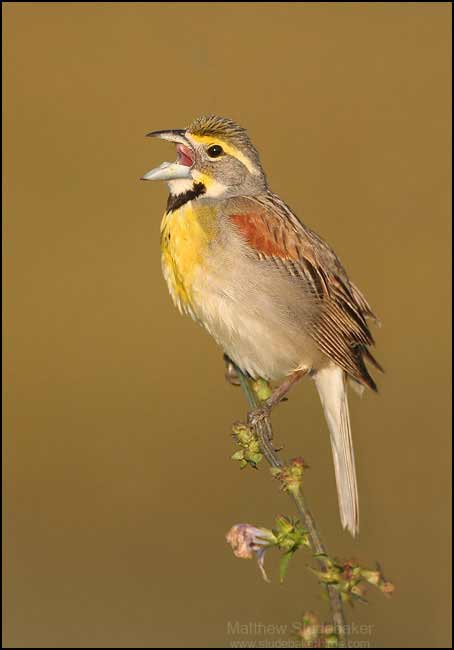
Dicksissel, singing, Valley National Park, Ohio
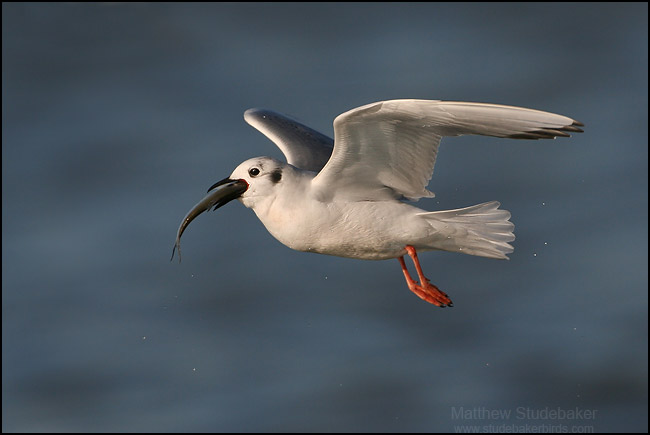
Bonaparte’s Gull with fish, E. 72nd Street, Cleveland, Ohio
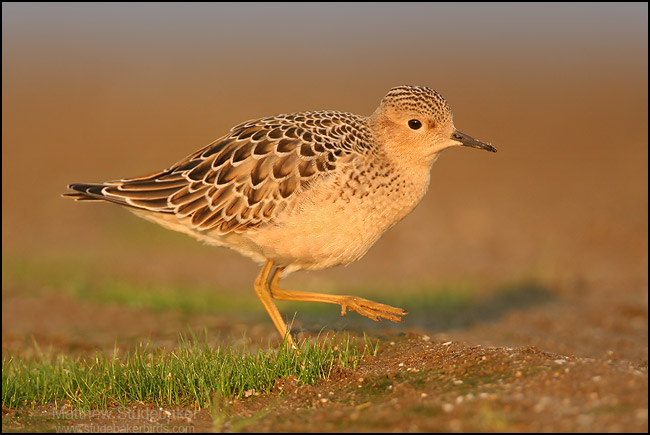
Buff-breasted Sandpiper, juvenile,
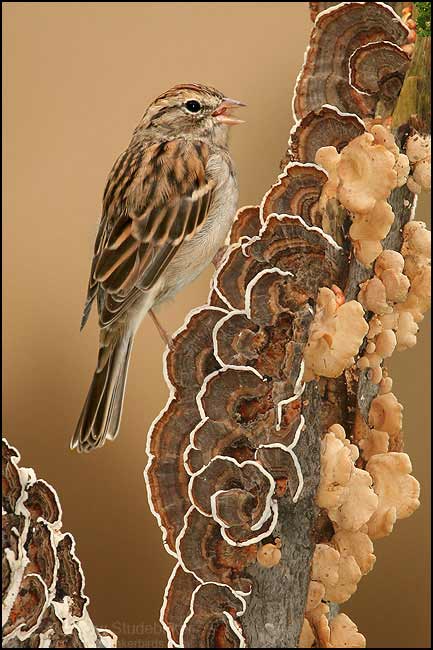
Chipping Sparrow,
VISUAL ECHOES BI-DIRECTIONAL GIMBAL HEAD ADAPTER (B-DGHA)
By mounting this lightweight
(5 ounces) bi-directional adapter on your (old or new) Wimberley Head you can
mount a short lens on your Wimberley Head. For bird or wildlife photographers
who like to create an occasional scenic photograph (while using slow shutter
speeds) the use of the B-DGHA provides a workable solution to a difficult
problem. You will--of course--need a camera body plate for your camera. For
creating horizontal images, we recommend using the generic Wimberley P-5
plate, but if you are interested in a camera-specific plate, go to
http://www.reallyrightstuff.com/ and click on the link for
plates for camera bodies.
Now, here is the part that
you will hear only from BAA: in order to use the bi-directional plate
successfully, you
will need to level the tripod platform by adjusting the legs so that the
floating bubble in the level on the tripod platform is centered in the scribed
circle. (This process is described in detail in the
Practicalities Chapter of ABP II on page 394.)
If you wish to create
vertical scenic images with a short lens, you will need to purchase an "L"
bracket. I do not like them. Routinely keeping one on your camera body
increases the weight of your rig by almost 1/2 pound and greatly impedes
camera body handling (as does keeping a camera body or wrist strap on camera
that is attached to a tripod-mounted lens.)
It is my belief that if you
are a serious landscape photographer you should be using a small, lightweight
ballhead.
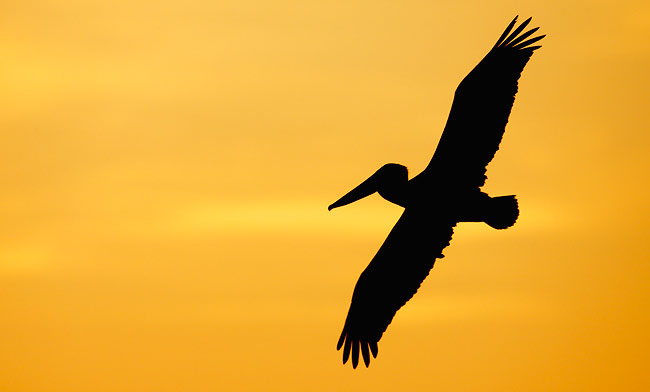
Brown Pelican at dawn, Tampa Bay, FL
Canon 600mm
f/4 L IS lens with the EOS-1D Mark IIN. ISO 640.
Evaluative
Metering + 1 2/3 stops off the sky: 1/500 sec. at f5.6. 45 Point AFPS.
JAMES SHADLE/MASTER PHOTOGRAPHER/MASTER NATURALIST
Over the past
few weeks I have gotten to know James Shadle better and it has been a
pleasure. He is driven, hard-working, talented, and just a helluva nice guy
(as is his son Blake). If you visit Jim’s web site (http://www.wildflorida.net/index.aspx),
you will quickly see that he is a fine photographer; be sure to check out the
Wildlife and the Abstract galleries. Most excellent photographers are
also—almost by necessity—excellent naturalists as well and James, having taken
the Freshwater Module of Florida University’s “Florida Master Naturalist”
program fits right into that category. His ability to spot small creatures
like rattlesnakes (swimming in salt water) and baby Diamondback Terrapins
borders on the supernatural (and he is—of course—a fine macro photographer).
“Fine Frog
Hair” James is just beginning work on a Greater Tampa Bay/Hillsborough County
Site Guide BAA Site Guide. James makes a living selling batteries and I only
half-jokingly said to him this morning that he should quit the battery
salesman ruse because looking at his web site you get the feeling that he
must be out there photographing 24/7/12… He knows a ton of great bird
photography sites that I have never even heard of much less visited.
Below are a
few examples of James’ work. The technical information is unavailable so
please go easy on the hate e-mails…
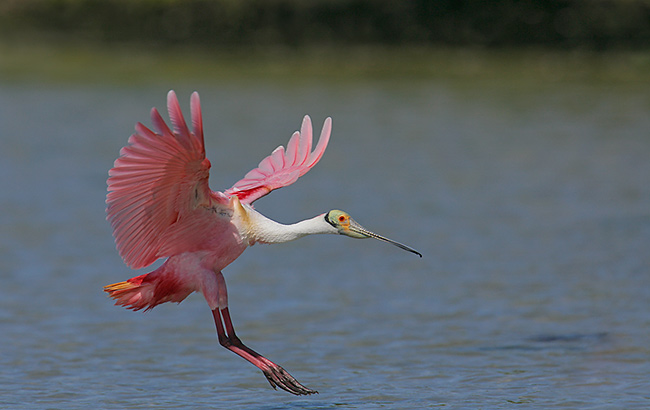
Roseate Spoonbill landing, Tampa Bay, FL
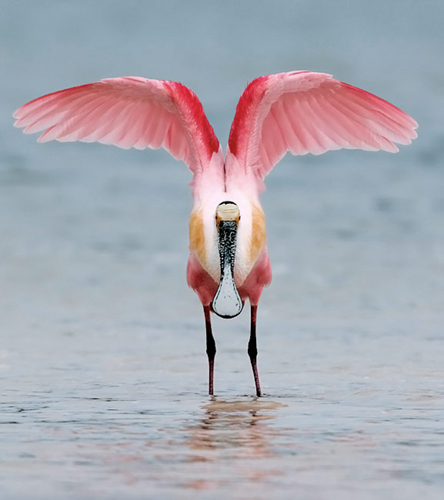
Roseate Spoonbill flapping, Tampa Bay, FL
JAMES SHADLE SPOONBILL BOAT TRIP OPENINGS
On the morning of Monday
April 16 both James and I will be providing in-the-field instruction on a
morning boat trip on
If you would like to
consider joining us on the 16th , the fare is $300 (if one person),
$250 each for 2-3 folks. There are currently three slots open.
James has two slots ($250)
open for tomorrow morning,
Please contact James as
follows:
contact
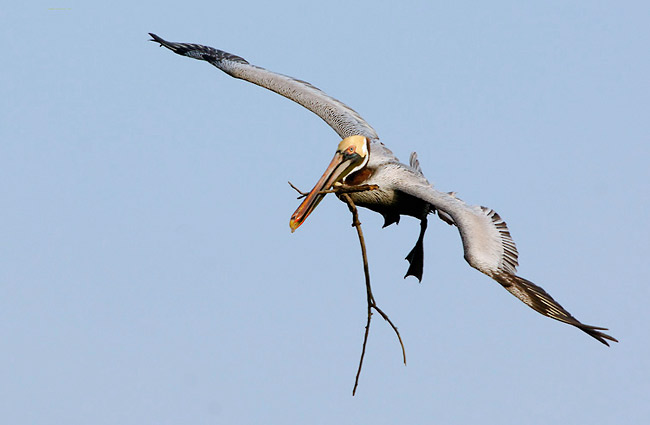
Brown Pelican with really big stick!, Tampa Bay, FL
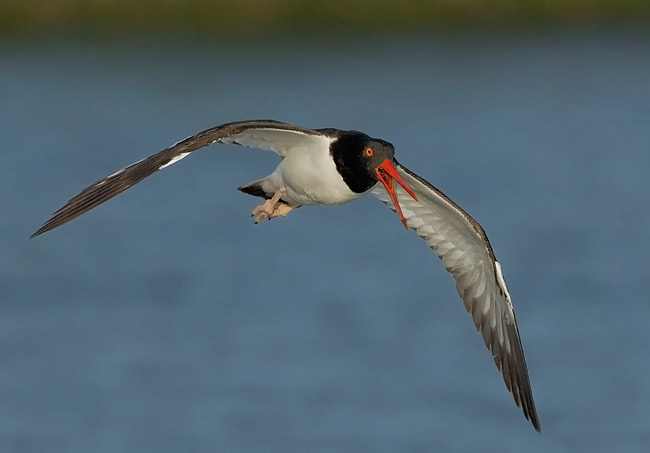
American Oystercatcher calling in flight, Tampa Bay, FL
Fort DeSoto IPT: APR 17-19, 2007.
Slide program on the evening of Monday, APR 16. 3-DAY: $999
(Limit 14;
openings: 4.)
Co-leaders: Todd
Gustafson, Robert O’Toole, and Alfred Forns. Courtship and
breeding behaviors of Laughing Gull and Royal and
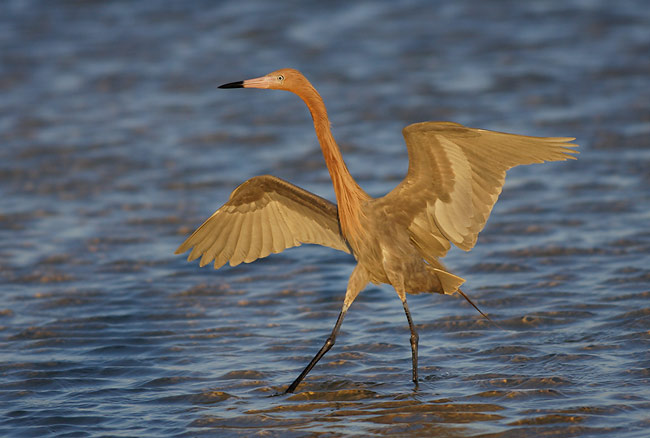
Reddish Egret dancing, Fort De Soto Park,
Canon 400m
f/5.6 L Lens handheld with the EOS-1D Mark IIN. ISO 400.
Evaluative
Metering +2/3 stop: 1/1000 sec. at f/5.6.
NYC SEMINAR
The Art of Nature Photography; It Ain’t
Just Birds!
Weekend How-To Seminar
The
seminar hotel is the Crowne Plaza JFK Hotel,
151 -20
Baisley Blvd.,
Jamaica ,
NY 11434.
The first 40 attendees who register to stay at least two nights at the
seminar hotel will receive a free Lens Pen Combo Kit—a
$20 value--plus our detailed instructions (those sent via e-mail). Room
rates anywhere in NYC are extremely high; we have negotiated a fantastic low
rate of $139 per night for those who register in a timely fashion. (The
lowest internet rate that I could come up with for the
Crowne
Plaza
was $161/night). To secure your room, please call 718-489-1000 with a credit
card in hand, state that you wish to make a BIRDS AS ART reservation, and give
them the confirmation code: BAA.
Please click here for additional details and schedule:
http://www.birdsasart.com/seminars.htm.
In
August, fall shorebird migration is well underway at the nearby Jamaica Bay
Wildlife Refuge. Photography at the East Pond there can be excellent,
especially for those who do not mind crawling in the mud and muck. Folks
joining us from out of town should strongly consider bringing their gear and
doing some photography at J-BAY, one of my favorite places on the planet, and
one of my three soul-places. I would advise staying on after the seminar
(rather than coming in early) as the juvenile shorebirds, which can be
extraordinarily tame, begin arriving in mid-August
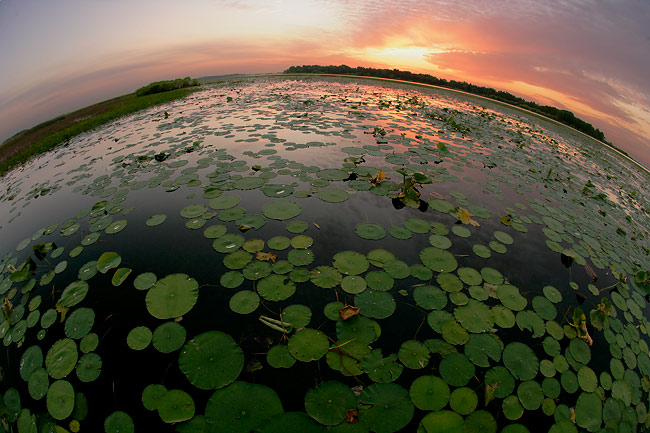
Lilly pad sunrise, West Lake Toho, Kissimmee, FL
Canon 15mm
fish eye lens, handheld with the EOS-1Ds Mark II. ISO 400.
Exposure set
by histogram evaluation: 1/80 sec. at f/7.1
With a
somewhat empty pre-dawn foreground, I asked
And remember, it ain’t just birds!
IPT UPDATES
Fort DeSoto IPT: APR 13-15, 2007.
Slide program on the evening of Thursday, APR 12. 3-DAY: $999 (Limit 12:
Sold Out.)
Co-leaders: Robert O’Toole, Alfred Forns,
and Robert Amoruso.
Courtship and breeding behaviors of Laughing Gull and Royal and
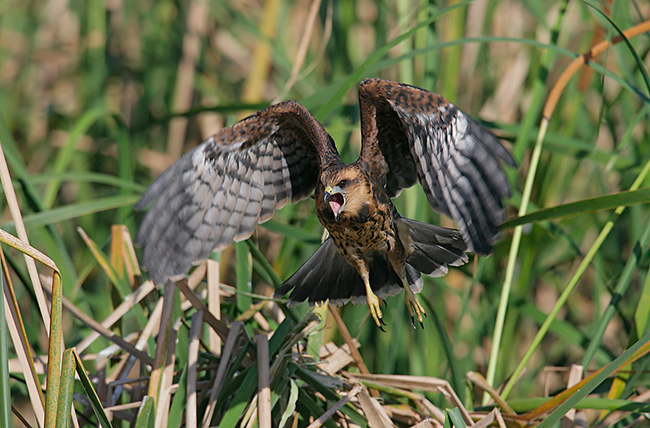
Snail Kite, fledgling taking flight, West Lake Toho, Kissimmee, FL
Canon 600mm
f/4L IS lens with the 1.4X II TC and the EOS-1Ds Mark II. ISO 400.
Evaluative
Metering off the reads +1/3 stop: 1/1250 sec. at f/8.
artie
Note:
Arthur Morris has been a Canon contract photographer since 1994 and continues
in that role today. Hunt's Photo of Boston, MA is a BAA sponsor as it Delkin
Devices. Back issues of all BAA Bulletins can be found in the Bulletin
Archives which may be accessed from the home page at
www.birdsasart.com